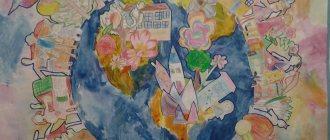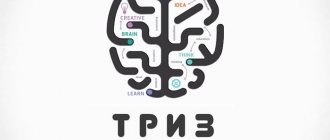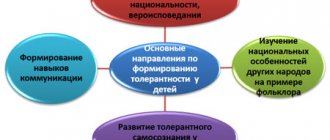Presentation “Getting to know the Library” presentation for the lesson (preparatory group) on the topic
Slide 1
Introduction to the library Prepared by Educator E.A. Zavyalova, group 8 of GBDOU No. 13 2015
Slide 2
Glued, sewn, no doors, but closed. Whoever opens it knows a lot. (Book.) - That's right - it's a book. Why do we need books? (To read, to learn new things, to study at school, to be smarter.)
Slide 3
Books Do you think it was convenient to read books written on clay tablets? (No, it’s inconvenient. They are heavy, it’s inconvenient to leaf through them.) - How long ago do you think books appeared? —What are books made of? (From paper) That's right, now books are printed on paper. But has it always been like this? No, guys, not always! Long ago, in the city of Babylon, it was invented and written on clay tablets,
Slide 4
Books - Therefore, in China they began to write books on bamboo plates, but this was also inconvenient. And the Chinese began to write books with a brush and ink on silk. And in Egypt they wrote books on stone slabs! You imagine that instead of books, you have stone slabs at home. It's comfortable? Therefore, they invented papyrus, very similar to paper, but very thin and long.
Slide 5
Books Parchment is a writing material made from leather. Birch bark letters - they were written on birch bark with wooden sticks. Which was called – Wrote.
Slide 6
Books - The first printed book in Russia was made by Ivan Fedorov. Ivan Fedorov did everything himself: he turned screws for his machine, cast forms for letters, and printed. He invented and published the first primer for children.
Slide 7
Books Contained tales of old, And Chernomor, And Tsar Guidon, And good grandfather Mazai... What is this house called? Try to guess! (Library.) Where are the books stored? (At home, on shelves, in bookcases. And in libraries.) - What is a library? This is a collection of books that one person or many people have collected and kept.
Slide 8
Books
Slide 9
Books There are many libraries now. There are school and district libraries. There are libraries for adults and for children. There are libraries for people of certain professions. You and I went on an excursion to the library, let's remember what we saw there and what new we learned.
Slide 10
There are so many books in libraries that it is difficult to find the right one among them. Directory indexes come to the rescue. There are cards in long drawers. On each is the title of the book and the author's last name. And in the corner there is a sign - numbers and letters. By this sign, the librarian immediately determines on which shelf and in what place the book is located. People who come to the library to buy books are called...? by readers.
Slide 11
Reading room Subscription
Slide 12
Library readers must follow certain rules. What do you think? A book borrowed from the library must be handled very carefully. After all, other guys will use it after you.
Slide 13
How should a reader behave in the library? Quiet! Don't lose library books! Handle books with care! Return books on time! Borrowed books must be placed in their place or on the librarian's desk.
Slide 14
Next year you will go to school. Be sure to sign up for the library. - Do you know how to handle books?
Slide 15
How to handle books They must be protected! You can’t draw on them. Fold the pages. Take them with dirty hands. You can't tear
Slide 16
Who works in the library? Where are the books kept? How should you behave in the library? What is the name of the place where people can read? How to properly handle books? What are the people called who go to the library to get books? What do we need to do to have a library in our group?
Slide 17
YOUNG READER The family wishes to see you once again. True story, fairy tale, tale and story - All old friends. But we don’t grow old, friends! Try to take a look, Unfold our pages - And good luck with the book!
The library in kindergarten is a center for the development of creative and intellectual abilities of pupils
A book is a great teacher and friend, without it the harmonious development of a person is unthinkable, because it forms not only memory, intellect, but also the imagination, moral and spiritual face of each of us. “Tell me what you are reading, and I will tell you who you are.” - this is how you can paraphrase a wise saying.
The results of studies over the past decades in a number of countries have shown: people who read are able to think problematically, have a larger memory capacity and an active creative imagination, speak better (it is more expressive, stricter and richer in vocabulary), formulate thoughts more accurately and write more freely; They make contacts more easily and are pleasant in communication, more critical, independent in judgment and behavior. Reading forms the qualities of the most developed and socially valuable person.
A preschooler needs a book. To see the whole multifaceted world, to be surprised by this world and understand it, to experience extraordinary adventures with the hero, to laugh with him, and sometimes to cry.
Also, in several generations of Russian families, the book is not listed as a priority spiritual value. An important indicator of ill-being is a deterioration in the content and quality of reading, and a decrease in its productivity.
Parents, loving their baby, buy him toys, treats, take him on visits and for walks. But not everyone knows that a child is no less, and sometimes even more, happy when his parents read a book to him.
Currently, educational institutions are faced with the task of introducing children to books, cultivating an interest in reading, and shaping a future reader. It is necessary to begin such work from a very early age, in the child’s first “social institution” - kindergarten.
I decided to start creating the library by interviewing parents and children of the senior and preparatory groups. 24 parents wished to participate in the survey.
The question “do you often read books to your child” was answered positively by 18 (75%) survey participants.
To the question “What does your child like to listen to most?”: 13 (54%) – fairy tales, 3 (12.5%) – poetry, 4 (17%) – educational literature; 4 (17%) – everything.
To the question “Do you consider a book a good gift?” 12 (50%) parents responded positively.
To the question “Is it necessary to compare the actions of children with the actions of literary heroes?” 16 (67%) respondents answered positively.
To the question “Will you use the library services at the preschool educational institution?” 17 parents (71%) responded positively.
While communicating with preparatory group students, I tried to draw attention to the fact that children have little interest in books and do not know how to use magazines.
Of the 16 guys interviewed:
10 (62.5%) could not accurately name the works they read at home and in kindergarten,
8 children (50%) could not name their favorite literary character,
9 pupils (56%) prefer to listen and read fairy tales, 5 (31%) - educational literature, encyclopedias, and only 2 people (12.5%) like to read poetry.
To the question “Who reads better?” 10 pupils (62%) said that their mother, 4 pupils (25%) like to listen to the teacher and 2 pupils (12.5%) like to read themselves.
Analyzing the questionnaires of parents and children, I came to the conclusion that it is necessary to teach children and their parents to love the book and develop their interest in it. In order to support and develop reading, the teachers of our kindergarten decided to make a feasible contribution to familiarization with the book, to the formation of a literate and thoughtful reader.
For this purpose, in January 2010, the Chitaika library was created - something between a public and home library, which will belong to all employees, parents and children. So far, the space allocated is small, all books are located on 3 shelves (fairy tales, poems and educational literature), but in the future it is planned to create a more expanded and spacious library.
See also: Citizenship for Jews
The purpose of creating the library
is the desire to teach a child to listen and hear the beauty of words, the rhythm, the meaning of a work, to see literary images, to emotionally perceive the content. All our efforts should be aimed at promoting reading. It is equally important to teach children to take care and appreciate books and use them correctly. Children learn not only to love reading. But also the ability to behave in the library, to find the works they need.
It is necessary to show children not only good literature and the best drawings, but also introduce them to publications of various formats, “Theater of Fairy Tale” books, books with thick cardboard pages.
I created forms for each child of the senior and preparatory groups with a photograph of each child.
This year I decided to create forms for each child and the children themselves drew a plot from a fairy tale or fairy-tale characters.
Books from the library can be taken home or to a group. You can come here at any time to read, watch books, watch a video, or just relax. Structure of the library collection: fairy tales, poems, educational literature and periodicals. On the shelves you can find individual works and collections of works by famous Russian writers, fairy tales from different peoples of the world, collections of games, riddles, proverbs and sayings, and children's songs. Priority is given to fiction, which plays an important role in the formation of the child’s social, moral, and aesthetic ideals. Understanding the special role of fairy tales in the development of a child, we paid great attention to their selection: the library contains Russian folk tales, fairy tales of the peoples of the near and far abroad, and fairy tales of the peoples of the North. Of particular interest to our pupils are periodicals for children: the magazines “Murzilka”, “Funny Pictures”, “Smeshariki”, “Filya”.
It is necessary to teach children to take care of books. Children should know that they cannot throw a book, tear it, draw on it, bend the corners of the pages, or cut out pictures and pages from it. A “Book Hospital” is organized monthly, where children enjoy repairing books and giving books a new life.
Every week I conduct various library events with the children, and once a month there is a big interesting holiday. In my work I use various methods:
Expressive reading aloud helps to create figurative ideas in the child, affects emotions and perception, helps to interest the child, and makes him want to listen to a familiar work again. Reading should be emotionally charged in order to hold the child's attention. Monotonous, monotonous reading with hesitations is unlikely to be listened to attentively, no matter how interesting the works are.
- Use of illustrative material - when reading works aloud, it is necessary to show the objects and characters depicted in the illustrations for the book.
- Illustrating works of children's literature - I suggest drawing a character you like or a plot you like.
- Modeling - make your favorite characters from plasticine.
- Literary quiz games based on the works of various authors.
After reading works of art, the children and I analyze in detail the artistic forms: portraits, the actions of the characters, their experiences and speech, everyday life, landscape, plot. Kindergarten teachers strive to teach the child to listen and hear the beauty of words, the rhythm, the meaning of a work, to see literary images, and to emotionally perceive the content. It is equally important to teach children to take care and appreciate books and use them correctly. Literary characters in our library “come to life” not only in dramatizations or puppet shows, but also in videos and presentations. From paper, cardboard, fabric, boxes, gloves, spoons, preschoolers make three-dimensional and flat figures of heroes of works, and draw memorable scenes. The kids really enjoy just looking at the pictures and communicating with each other.
The main principle of the educational program of the Penguin kindergarten is a complex thematic one, where the approximate holiday calendar is taken as a basis. I plan the work of the library in accordance with the annual plan of the Penguin Children's Educational Institution (Appendix 1).
Twice a year, the kindergarten holds “Children’s Book Week” for its pupils – in October, timed to coincide with International Library Day, and in May – on All-Russian Library Day. Preparing for Children's Book Week does not require large time, material or organizational costs. It should be noted that during such thematic weeks, parents are most actively involved in the educational process: they participate in holidays, competitions, select materials for exhibitions, and make crafts together with their children. From time to time I take an active part in parent-teacher meetings of the preschool educational institution. One of the speeches and presentations can be seen in Appendix 2.
The following events are held as part of Children's Book Week:
- thematic exhibitions (“My favorite book”, “Our family’s favorite books”, “Books of our parents”);
- fairy tale dramatizations;
- book illustration;
- making bookmarks for books;
- organization of the “Book Hospital”;
- thematic leisure activities “Where the book came from”, “Journey into the history of the book”;
- viewings of cartoons and filmstrips about the creation of books and filmed works of fiction;
- reading fiction;
- work in book corners.
Fairy tales are the favorite literary genre of our kindergarten children. This is explained by the fact that the fairy tale is understandable and is structured in such a way that the child gradually develops along with it, learns simple concepts of good and evil, friendship and enmity, love and hatred. With the help of a fairy tale, the emotional sphere of a child develops, who worries about the fate of the main character. And there is hardly a child who disagrees with the fact that in a fairy tale, good always triumphs over evil.
At the creative classes “Composing” the guys and I compose new stories, discuss them, everyone expresses their opinion and all together we compose new fairy tales (Appendix 3).
Children really like these activities and they do them with pleasure. At the end of creative work, children sketch a fairy tale.
During library classes on studying our native land, we worked on creating the “ABC of Yamal” for children, in which preschoolers could not only learn letters, but also get acquainted with the animals, birds that live in our area and the peoples inhabiting our region. For about three months, the children happily selected materials to create the alphabet and, upon completion of the work, they drew on the theme “Our home is Yamal!” (Appendix 4).
The creation of our library is largely an experimental activity, but its work is already producing positive results: children’s attitude towards books is changing, they enjoy listening to literary works, and they willingly take part in dramatization games and library festivals.
The developed system of work and cooperation between the preschool institution and parents increased children’s interest in the book, forming the social and moral education of the individual.
I would like to note that the level of children’s speech development over the two years of the library’s existence has increased among children in the senior and preparatory groups. The diagnostic results are as follows:
Monitoring the quality of knowledge on speech development of the preparatory group at the beginning and end of the 2010-2011 academic year.
Book design
Tatiana Fedotova
Book design
It is known that reading experience begins to develop from early childhood. By instilling a love for books, we help the child learn about the world around him and himself in it, form moral feelings and develop the perception of the literary word.
LIBRARY DAY will take place on May 27th . Library of Fairy Tales in our group .
To coincide with this day, the collective of the group “Bell” timed the thematic week “In the world of fairy tales ”. Several tasks were set:
- introduce children to various types of fairy tales ;
- develop creative abilities: thinking, memory, imagination;
— to form in children a general idea of the culture of their people, its richness and diversity;
— consolidate the ability to use means of expression: facial expressions, intonation, postures, gestures;
- instill interest in fairy tales ;
— to cultivate in preschool children the attitude of an active reader, interest and respect for the book.
“In our group “Bell” we settled fairy tales ,
All week, we are friends, we were friends with fairy tales ,
We all played “Three Bears” and “Kolobok”,
The group created an exhibition, even composed fairy tales ,
We read books together and performed in the theater!
And our teachers helped us with everything!”
The children of our group showed the fairy tale “Kolobok” to the kids in our kindergarten.
They acted out fairy tales on a flannelgraph .
We visited our “ Library of Fairy Tales ”.
My Family’s Favorite Fairy Tales” was organized . Parents and children drew pictures for their favorite fairy tales and created baby books .
See also: Agreement with yourself template
“Can you imagine for a moment how we would live without books?
What would a student do if there were no books?
If everything disappeared at once, what was written for children:
From good magical fairy tales to funny stories .
You wanted to relieve boredom and find an answer to the question.
I reached out for the book , but it wasn’t on the shelf!
No, it is impossible to imagine that such a moment would arise,
And all the heroes of children's books could have left you. "
All events brought a lot of joyful impressions to the children and aroused a lot of positive emotions. They read poetry with great pleasure, drew heroes of their favorite fairy tales , dramatized, sang and danced.
Master class for teachers “Designing a book corner” Authors: Chernyavskaya Nadezhda Fedorovna Barinova Valentina Pavlovna A house in which there is no book is like a body without a soul. With this statement.
Decoration of kindergarten. Our library Introduce children to the principles of the library, teach them how to properly use a children's library. Introduce children and parents to the bookstore.
Design of the Nature Center Good afternoon, dear colleagues! Let me share with you my experience in designing the Nature Center. My partner and I decided to mark the times.
Design of an entertaining mathematics center Here is a variety of didactic games for the development of attention, logical thinking, and motor skills. They are also offered for children.
Designing an information center for parents on traffic rules in the middle group The main purpose of designing an information center on traffic rules for parents is to convey to them that they are the main link in education.
Decorating a book corner In our kindergarten No. 33 “Sun” there was a review of book corners. We tried to make it as attractive as possible for children where the child is.
Decorating the book corner “Book Tree” I thought for a long time about how to decorate the book corner in the group. It had to be understandable to both the children and me, correspond to the themes of the week, and the times.
Decoration of mini- Good day everyone! The long-awaited time has come for children, when they can find a lot of entertainment on the street. And in order to secure it.
Memo for educators “Designing a book center in a preschool educational institution” Memo: “Designing a book center in a preschool educational institution” The book center in a preschool educational institution is a necessary element of the developmental environment in a group room. Basics.
Decoration of the book corner Storyteller: Once upon a time there was a Kolobok - a ruddy side. And he loved to travel to different countries and write poetry. Such a creative nature...





